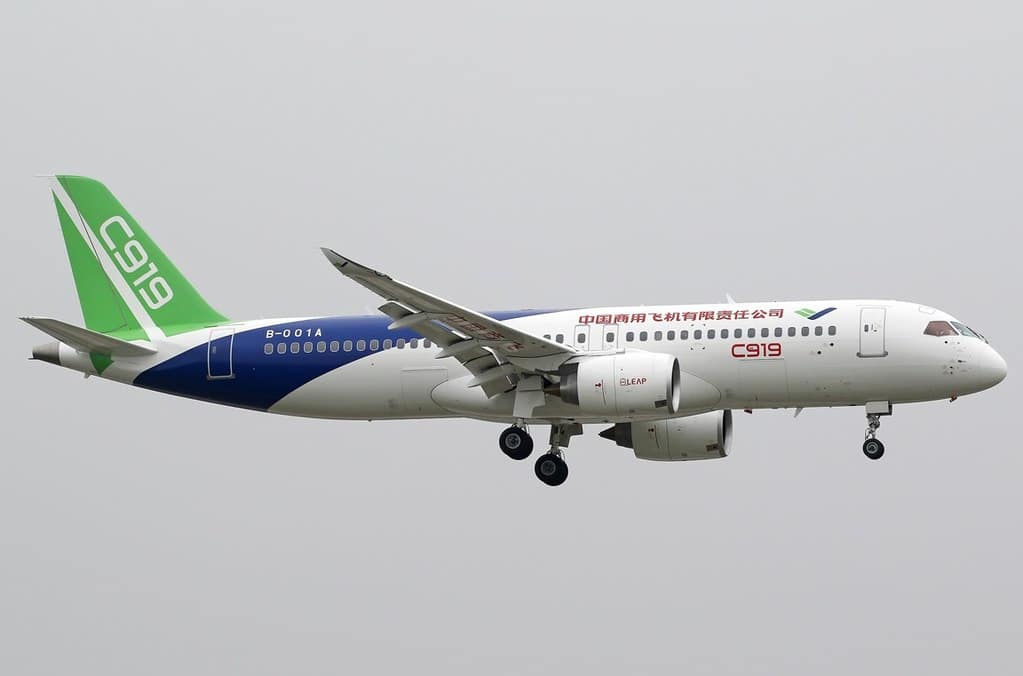Aviation
COMAC C919 Successfully Completes Flight Tests
According to Commercial Aircraft Corp of China, the aircraft’s manufacturer, the single-aisle C919 passenger jet has finished all the necessary test flights to get a national airworthiness certificate. It is awaiting its launch on the market. #C919 #Comac

In celebration of the six C919 flight test aircraft successfully completing all of their flight tests on July 19, 2022, Yanliang theatre command of the C919 flight test on-site integrated command hosted a summary meeting at Weinan Huashan Airport in Shaanxi province.
The six C919 flight test aircraft had successfully completed all of the flight tests, indicating that the certification of the C919 aircraft had reached its completion and that full-scale attempts to obtain certification had commenced.
China’s first C919 passenger jet completes its first flight, Before delivery.
This is a significant staged achievement of the C919 programme made possible by the CPC Central Committee, with Comrade Xi Jinping at its core. All six of China’s C919 aircraft have successfully completed their flying tests.
The process of flight test of C919 aircraft was reviewed and summarized, and exchanges and speeches were made by relevant representatives including test pilots and flight test engineers.
Airbus’ lead over Boeing in China is shrinking as Comac prepares to launch its new C919 plane.
The COMAC C919 aircraft specification and orders
The narrow body Comac C919 provides a 158 seat, two class cabin arrangement, as well as 168 and 174 seats in a single class configuration. The C919, China’s first independently created trunk jetliner, has a range of 4.074 kilometres. The maximum takeoff weight is 78.900 kg.The aircraft is powered by the CFM leap -1c engine, which is based on the -1A engine that powers the Airbus A320neo.
First made-in-china large commercial aircraft , C919 rolled off production line
With a fuselage length of 3.96 metres and a height of 4.166 metres (13.67 feet), it could be possible to use a single unit load system for both aircraft. Its wingspan measures 33.6 m (110 ft), and its intended cargo capacity is 0.4 tonnes. The design aims for an operating ceiling of 12,200 metres and a cruise speed of Mach 0.785 (450kn) (39,800ft).
As of 31 August 2018, Comac has 1008 commitments including 305 firm orders, mostly from Chinese leasing companies or airlines.

Aviation
Boeing, Antonov to Collaborate on Defense Projects

– MOU represents Boeing’s commitment to work with Ukrainian industry
– Includes exploring opportunities for collaborating on in-country support of Unmanned Aerial Systems
A Memorandum of Understanding was signed today by Boeing and Antonov Company to investigate potential collaboration on defense-related projects.
“We’re happy to keep collaborating with the Antonov Company to help Ukraine’s economic development and expansion,” stated Ted Colbert, CEO and president of Boeing Defence, Space, & Security.
Airbus and the Antonov An-225: The Best Partnership:Click here
“This agreement demonstrates our ongoing efforts to find more opportunities to work with Ukrainian industry, which was underscored by our signing of the Ukrainian Defence Industry Compact earlier this year.”
The areas of potential collaboration identified in the agreement consist of training, logistical support and overhaul services for tactical Unmanned Aerial Systems utilized by the Ukrainian Armed Forces, which includes the ScanEagle. In addition, the companies will also explore opportunities for Antonov to provide engineering support to Boeing.
The six largest cargo aircraft ever built in the aviation industry:Click here
“A strong, innovative, and efficient defense industry is key to sustainable economic development and national security, and we are extremely excited to collaborate with Boeing,” said Ievhen Gavrylov, CEO of Antonov Company.
This agreement brings a whole new level of opportunity to implement the latest and most effective solutions – in addition to the possibility of future projects with Boeing in the aerospace and defense industry.”
-

 Travel1 week ago
Travel1 week agoAir India to Expand US Operations with Three New Routes After a Decade
-

 Travel2 weeks ago
Travel2 weeks agoWhy We Should Avoid These Stamps in a Passport
-

 Airlines1 month ago
Airlines1 month agoInvestigations Reveal Fake Chinese Titanium in Boeing and Airbus Jets
-

 Tech4 weeks ago
Tech4 weeks agoChina’s CATL Plans 1,800-Mile Electric Plane Launch by 2027
-

 Airport3 days ago
Airport3 days agoTop 10 Largest Airports in the World by Size
-

 Aerospace4 weeks ago
Aerospace4 weeks agoChina’s Fighter Jets Turn Wings into Autonomous Drones
-

 Airlines4 days ago
Airlines4 days agoAir India Rolls Out A350s for Delhi-New York JFK and Newark Routes
-

 Defence3 weeks ago
Defence3 weeks agoBoeing Enhances Chinook with New Engines and Block II Upgrades at $96 Million







